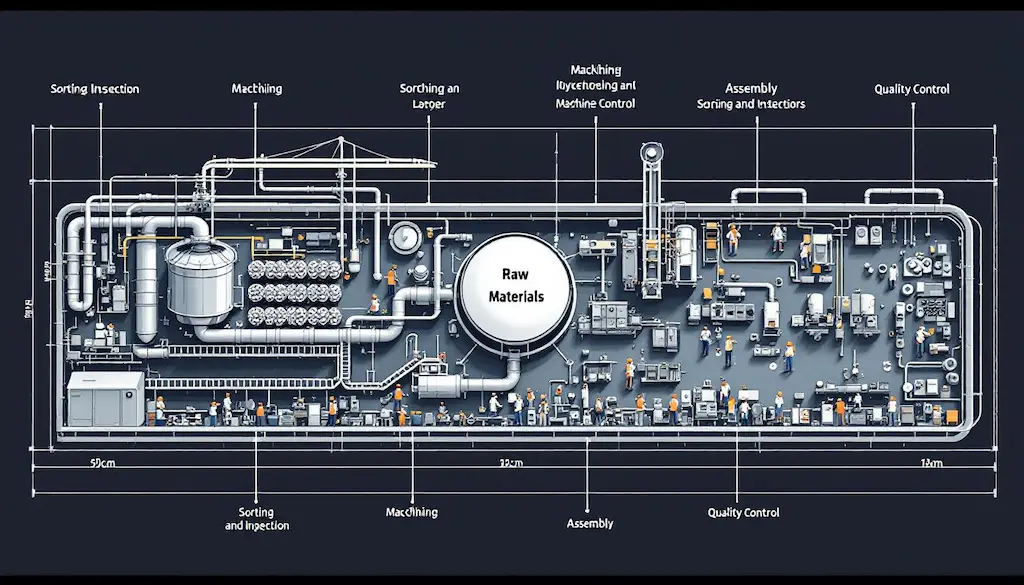Manufacturing quality control ensures products meet standards and maintain consistency. It prevents defects, reduces costs, and protects brand reputation. This article covers top strategies and methods to implement effective quality control in manufacturing.
Key Takeaways
- Quality control in manufacturing is vital for ensuring product quality, regulatory compliance, and brand reputation while reducing costs and waste.
- Key quality control methods include Statistical Quality Control (SQC), Total Quality Management (TQM), and Six Sigma, each focusing on defect prevention and continuous improvement.
- Implementing effective quality control procedures, including employee training, regular inspections, and setting quality standards, significantly enhances product quality and customer satisfaction.
Understanding Quality Control in Manufacturing
Quality control involves processes and systems aimed at ensuring products meet specified requirements. It also focuses on maintaining consistency and reliability in the products.
In the manufacturing industry, this involves a series of activities, procedures, and techniques aimed at assessing product quality and preventing defects from occurring in production processes.
The primary goal is to:
- Deliver products without defects
- Manage costs
- Reduce waste
- Protect brand reputation
Strict quality control standards positively influence brand reputation, encouraging repeat customers and overall business success.
Quality control in manufacturing is extremely important. Its significance cannot be overstated. It ensures that products meet desired quality levels, enhancing overall safety and reliability for consumers. Moreover, quality control helps manufacturers maintain compliance with industry regulations, which fosters customer trust and loyalty. Effective quality control systems are crucial for regulatory compliance. They also serve as a strategic asset in today’s manufacturing environments. Without these systems, there is an increased risk of not meeting quality targets and experiencing cost inefficiencies.
Quality control focuses on detecting and addressing defects throughout the production stages to ensure conformity with standards. This involves strict adherence to processes, as deviations can lead to out-of-spec products. By ensuring that products consistently meet customer expectations, quality control fosters customer trust and loyalty, ultimately contributing to business success.
Key Quality Control Methods
There are several key quality control methods used in manufacturing, each with its own set of principles and applications. These methods include Statistical Quality Control (SQC), Total Quality Management (TQM), and Six Sigma. Each quality control method plays a crucial role in the quality control process, helping manufacturers implement effective quality control measures and maintain high-quality standards.
Let’s explore these methods in detail to understand how they contribute to producing high-quality products.
Statistical Quality Control (SQC)
Statistical Quality Control (SQC) involves using statistical methods to monitor and control manufacturing processes to ensure consistent product quality. One common technique in SQC is acceptance sampling, where a portion of products is sampled and inspected for defects. This method relies on sampling either at scheduled or random points in production to identify quality control issues. Techniques like control charts are employed in SQC to visualize product variation and identify acceptable limits. The key benefit of using SQC is the early detection and prevention of defects, leading to improved overall quality.
Increasing sample sizes in SQC helps to better represent the quality of the larger batch of products. SQC identifies and addresses variations in the production process that may lead to product defects. Implementing SQC helps manufacturers meet required quality standards and maintain customer satisfaction.
Total Quality Management (TQM)
Total Quality Management (TQM) is a philosophy and method for improving quality by incorporating it into the company culture and training staff to identify and address problems. The primary goal of TQM is long-term success through customer satisfaction. TQM seeks to improve the quality of products and services by empowering employees to take ownership of quality control and intervene when necessary. TQM involves employees at all levels improving quality efforts.
TQM is characterized by a data-driven approach focused on continuous improvement. This involves creating and implementing processes that identify and repeat successful products. Today’s TQM programs are enhanced by linking them to data management platforms like MachineMetrics. Integrating quality improvement into company culture helps manufacturers maintain high standards and achieve long-term success.
Six Sigma
Six Sigma is a data-driven methodology for improving product quality by reducing defects and variations. The aim of Six Sigma is to improve processes by discovering and eliminating defects. Six Sigma aims to achieve a maximum of 3.4 defects per million units produced, focusing on process improvement and defect elimination. Six Sigma involves several key steps. These include defining the problem, measuring the current process, and analyzing the root causes of variations and defects.
Following these steps helps manufacturers achieve near-zero defects. This methodology not only improves product quality but also enhances operational efficiency and customer satisfaction. Implementing Six Sigma in manufacturing processes can lead to significant improvements in overall quality and competitiveness.
Implementing Quality Control Procedures

Implementing quality control procedures is essential for minimizing defects, ensuring safety and functionality, and maintaining high product quality standards. A quality control plan is a document outlining the procedures, tools, documentation, and metrics for implementing quality control. This plan helps manufacturers align their quality control strategy with unique product attributes, ensuring compliance with industry standards and validating customer trust.
Key components of implementing quality control include setting quality standards, conducting regular inspections and testing, and implementing quality control training employees.
Setting Quality Standards
Setting quality standards is crucial for the success of quality control in manufacturing. Intent-driven QC standards are essential for producing successful products. These standards should reflect customer expectations to enhance satisfaction and compliance with regulations. Quality control processes confirm that products adhere to industry regulations and standards, ensuring safety and reliability.
Regular audits are necessary to ensure adherence to quality standards and identify areas for improvement. By establishing measurable quality standards and conducting regular audits, manufacturers can maintain high-quality products and meet customer expectations.
Regular Inspections and Testing
Regular inspections and testing are vital for identifying and addressing defects early in the manufacturing process. The early detection of deficiencies helps ensure timely product delivery, maintaining customer trust and satisfaction. Quality control methods such as 100% inspection involve thoroughly checking every part or assembly for defects, which is crucial in industries like automotive and medical devices.
Inspections should be conducted at every stage of the manufacturing process to monitor quality, rather than just on the final product. Tools such as quality control charts and check sheets are used to track defects over time and systematically record quality issues during testing.
Implementing regular inspections can lead to reduced labor and supply costs by identifying issues early in the production cycle.
Training Employees
Training employees is essential for ensuring consistent, high-quality products. In-depth training in quality control can significantly minimize errors and boost overall product quality. Total Quality Management (TQM) integrates quality improvement into the company culture and involves training all employees to recognize and resolve issues. Insufficient training and knowledge among manufacturing personnel can lead to persistent quality control issues.
Investing in employee training enhances quality control efforts and maintains high standards.
Tools and Techniques for Quality Control

Several tools and techniques are used in quality control to ensure product quality and improve manufacturing processes. These include quality control techniques, quality control charts, Pareto analysis, and check sheets. Each tool plays a crucial role in identifying defects, monitoring process data, and systematically gathering information on quality issues.
Exploring these tools in detail reveals their applications and benefits in quality control.
Quality Control Charts
Quality control charts provide a visual representation of process data over time, allowing for quick identification of trends and deviations. An X-bar chart is utilized to keep track of the mean of consecutive samples. These samples are of a constant size. These charts can measure characteristics such as weight, temperature, and thickness. The Y-axis on an X-bar chart indicates the degree to which the deviation of the tested attribute is acceptable.
Quality control charts allow manufacturers to easily track process performance and identify variations that may lead to defects. This helps in maintaining high-quality standards and ensuring that products meet customer expectations.
Pareto Analysis
Pareto analysis helps manufacturers focus on the most frequent causes of defects by prioritizing issues based on their impact. This statistical method is based on the principle that a small number of causes often lead to a large percentage of problems.
Identifying and addressing these critical causes significantly improves product quality and reduces defects.
Check Sheets
Check sheets enable teams to systematically gather data on defects, making it easier to analyze and resolve recurring issues. These sheets are vital tools in quality control that help organizations track and manage defects systematically.
Check sheets help manufacturers identify patterns in quality issues and implement corrective actions to prevent future defects.
Benefits of Effective Quality Control

Effective quality control measures offer numerous benefits, including improved customer satisfaction, cost reduction, and enhanced brand reputation. Catching defects early prevents poor-quality products from reaching consumers, reducing operational costs and increasing profits.
Let’s delve into these benefits to understand how quality control can transform your manufacturing processes.
Improved Customer Satisfaction
Quality control plays a critical role in ensuring that products meet or exceed customer expectations. Products meeting or exceeding expectations enhance customer satisfaction and loyalty.
When product quality is consistently high, customers are more likely to trust the brand and recommend it to others. Happy customers lead to brand loyalty and long-term profits for the company.
Cost Reduction
Identifying defects early helps avoid significant costs associated with returns and lost sales. Effective quality control can decrease material waste, leading to lower production costs. Minimizing production costs related to rework, scrap, and customer returns leads to substantial cost savings.
Products that consistently meet quality standards foster stronger customer loyalty and repeat business, further driving down costs.
Enhanced Brand Reputation
High-quality products are essential for building a positive brand reputation. Maintaining high quality consistently strengthens a brand’s image and positively influences customer perceptions. A strong reputation for quality can differentiate a brand from its competitors in the market.
Additionally, a reputable brand can leverage its quality perception to enhance competitiveness in the industry, securing a loyal customer base.
Challenges in Maintaining Quality Control

Maintaining quality control in manufacturing comes with its own set of challenges. These include managing supplier quality, adapting to technological changes, and ensuring compliance with industry regulations. Each of these factors can significantly impact product quality and the overall effectiveness of quality control measures.
Understanding and addressing these challenges is crucial for manufacturers to maintain high standards and achieve manufacturing excellence.
Managing Supplier Quality
Choosing the right suppliers is crucial for ensuring the quality of raw materials, which directly affects the final product’s integrity. Overlooking supplier quality can significantly disrupt production workflows and lead to quality issues down the line. Not applying uniform quality criteria across various departments can negatively affect overall product quality.
Implementing strict quality control measures for suppliers helps maintain consistent and high-quality standards.
Adapting to Technological Changes
The rapid advancement in digital technologies necessitates that quality assurance and control systems evolve accordingly, integrating real-time data monitoring and IoT devices. QA/QC departments must ensure robust data traceability and security as digitalization intensifies, particularly given the sensitive nature of product data they manage.
To cope with dynamic supply chain requirements, QA/QC processes need to be flexible and capable of rapid adaptation to diverse materials and testing standards.
Ensuring Compliance
Quality control ensures that products meet industry regulations and safety standards. It verifies that production follows specifications, upholding quality standards and preventing legal liabilities, fines, and damage to brand reputation.
Failing to meet quality standards can result in significant consequences, making compliance a critical aspect of quality control.
Future Trends in Quality Control
The future of quality control in manufacturing promises to be transformative and indispensable. Emerging technologies are significantly impacting quality control methods. These include the Industrial Internet of Things (IIoT), artificial intelligence (AI), and machine learning. These advancements enhance the quality control process by providing real-time data analysis, predictive analytics, and decision support.
Let’s explore these future trends to understand their potential impact on manufacturing processes.
Integration of AI and Machine Learning
Integrating AI and machine learning into quality control processes can significantly enhance efficiency and effectiveness. AI enables predictive analytics that help manufacturers anticipate potential quality issues before they arise. Leveraging these technologies helps manufacturers make informed decisions and implement timely corrective actions, improving product quality and reducing defects.
Industrial Internet of Things (IIoT)
Connected devices within the Industrial Internet of Things (IIoT) enable seamless communication and data exchange throughout the manufacturing process. These devices provide manufacturers with the ability to monitor production lines, ensuring that quality control parameters are consistently met.
Real-time data collection from IIoT devices allows for immediate insights into production quality, helping to quickly identify defects or irregularities. With immediate access to actionable data, manufacturers can implement timely corrective actions, enhancing their overall quality management framework.
Advanced Quality Control Software
Advanced quality control software solutions, such as Quality Management Systems (QMS), help companies comply with quality standards and provide real-time production data. Integrating these platforms with other software extends capabilities to the entire enterprise, supporting operational decision-making by providing immediate data in accessible formats.
These software solutions leverage big data analytics to provide insights that improve quality control efficiency and ensure compliance with quality standards.
How ASC Software Enhances Manufacturing Quality Control
ASC Software provides advanced solutions for manufacturing quality control, ensuring that businesses maintain high standards, reduce defects, and improve operational efficiency. With its powerful Warehouse Management System (WMS) and Manufacturing Execution System (MES), ASC Software helps manufacturers implement effective quality control measures at every stage of production.
Key Features Supporting Quality Control
ASC Software’s solutions integrate seamlessly into manufacturing workflows to enhance quality assurance through:
- Real-Time Quality Monitoring: Gain immediate visibility into production quality with real-time data collection and automated alerts for deviations.
- Traceability & Compliance: Track raw materials, work-in-progress, and finished goods with full traceability, ensuring regulatory compliance and quality standards.
- Defect Prevention & Root Cause Analysis: Advanced analytics tools help identify potential defects early in the production process, minimizing waste and rework.
- Automated Workflows & Inspection Processes: Ensure consistency with automated quality checks and standardized workflows, reducing human errors and improving efficiency.
- Integration with ERP & IoT Systems: Connect with enterprise systems and smart manufacturing devices to streamline data flow and decision-making.
Enhancing Quality Control with ASC Software
By implementing ASC Software’s solutions, manufacturers can strengthen their quality control strategies, reduce production costs, and improve customer satisfaction. Whether through automated inspections, advanced reporting, or process optimization, ASC Software empowers manufacturers to maintain high-quality standards while increasing operational efficiency.
Summary
Effective quality control is the backbone of successful manufacturing, ensuring products meet high standards while minimizing defects, reducing costs, and strengthening brand reputation. Strategies like Statistical Quality Control (SQC), Total Quality Management (TQM), and Six Sigma provide structured approaches to maintaining consistency and customer satisfaction. However, manufacturers must also navigate challenges such as supplier quality management, evolving technologies, and regulatory compliance.
Looking ahead, innovations like AI-driven analytics, Industrial Internet of Things (IIoT), and advanced quality control software are transforming how manufacturers detect and prevent defects, enabling smarter, data-driven decisions. By continuously refining quality control processes, businesses can boost efficiency, enhance competitiveness, and build long-term customer trust—positioning themselves for sustainable success in an increasingly demanding market.
Looking to enhance your manufacturing quality control? Explore ASC Software’s solutions to improve efficiency, ensure compliance, and achieve consistent product quality. Contact us today to learn more!
Frequently Asked Questions
What is quality control in manufacturing?
Quality control in manufacturing ensures that products meet specified requirements and are consistently reliable by implementing procedures for testing, verifying, and improving production processes. Ultimately, it helps identify and rectify any defects to enhance product quality.
What are the 5 M’s of quality control?
The 5 M’s of quality control are man, machine, materials, methods, and measurement. These elements are essential for identifying and addressing potential quality issues in production.
What is the primary goal of quality control in manufacturing?
The primary goal of quality control in manufacturing is to ensure products meet specified requirements, remain consistent and reliable, and prevent defects from reaching consumers. This focus on quality safeguards customer satisfaction and the integrity of the brand.
What are the main methods of quality control in manufacturing?
The main methods of quality control in manufacturing are Statistical Quality Control (SQC), Total Quality Management (TQM), and Six Sigma. These approaches help ensure the consistent quality of products and continuous improvement in processes.
How does Total Quality Management (TQM) improve product quality?
TQM enhances product quality by embedding a culture of quality within the organization, training employees to recognize and solve issues, and emphasizing ongoing improvement. This systematic approach ensures better products and increased customer satisfaction.




